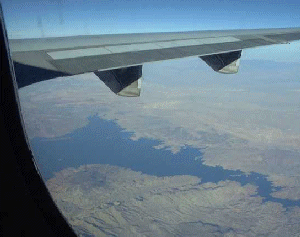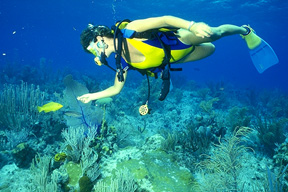Here's a scuba diver making friends with a fish!
Click on image for full size
Courtesy of Corel Photography
Open-Circuit Scuba
Scuba stands for self-contained, underwater breathing apparatus. It means that scuba divers carry all of the breathing medium they need with them for the duration they are underwater. Open-Circuit scuba is different than Closed-Circuit scuba and Semi-Closed Circuit scuba.
In Closed-Circuit scuba there is a total recirculation of the gas supplied to the diver. In Semi-Closed Circuit scuba, some of the gas is reused by the diver. In contrast, the gas supplied during Open-Circuit scuba is not recycled at all. When a diver breathes out, the exhalation goes out to the surrounding water instead of being recirculated somehow.
In Closed-Circuit scuba, oxygen and mixed gas are used as the gas supply for the diver. In Semi-Closed Circuit scuba, mixed gas is used as the gas supply. In contrast, Open-Circuit scuba uses mixed gas and air as the gas supplies, with air being the main gas supply for Open-Circuit scuba divers.
There are risks involved in all kinds of scuba diving. Adequate training, experience, the presence of a dive buddy, and observation of dive tables should minimize the risks so that Open-Circuit can be a safe and enjoyable experience.
You might also be interested in:

Take a look at this picture! The light blue parts are coral reefs just under the surface of the Red Sea. The crew of the International Space Station (ISS) took the picture on May 20, 2003 as they looked
...more
An aquifer is the name for a layer of rock which is capable of holding a large amount of water. Some layers are better at holding water than others, for example a layer of sandstone can hold a good deal
...more
Carbonate is a name for rocks and minerals which contain a molecule made of both carbon and oxygen known as CO32-. (CO32- is also known as the molecule carbonate). Limestone is an example of a calcium
...more
One process which transfers water from the ground back to the atmosphere is evaporation. Evaporation is when water passes from a liquid phase to a gas phase. Rates of evaporation of water depend on things
...more
The water at the ocean surface is moved primarily by winds that blow in certain patterns because of the Earth’s spin and the Coriolis Effect. Winds are able to move the top 400 meters of the ocean creating
...more
Rivers are very important to Earth because they are major forces that shape the landscape. Also, they provide transportation and water for drinking, washing and farming. Rivers can flow on land or underground
...more
About 70% of the Earth is covered with water. Over 97% of that water is found in the oceans. Everyone who has taken in a mouthful of ocean water while swimming knows that the ocean is really salty! Dissolved
...more















